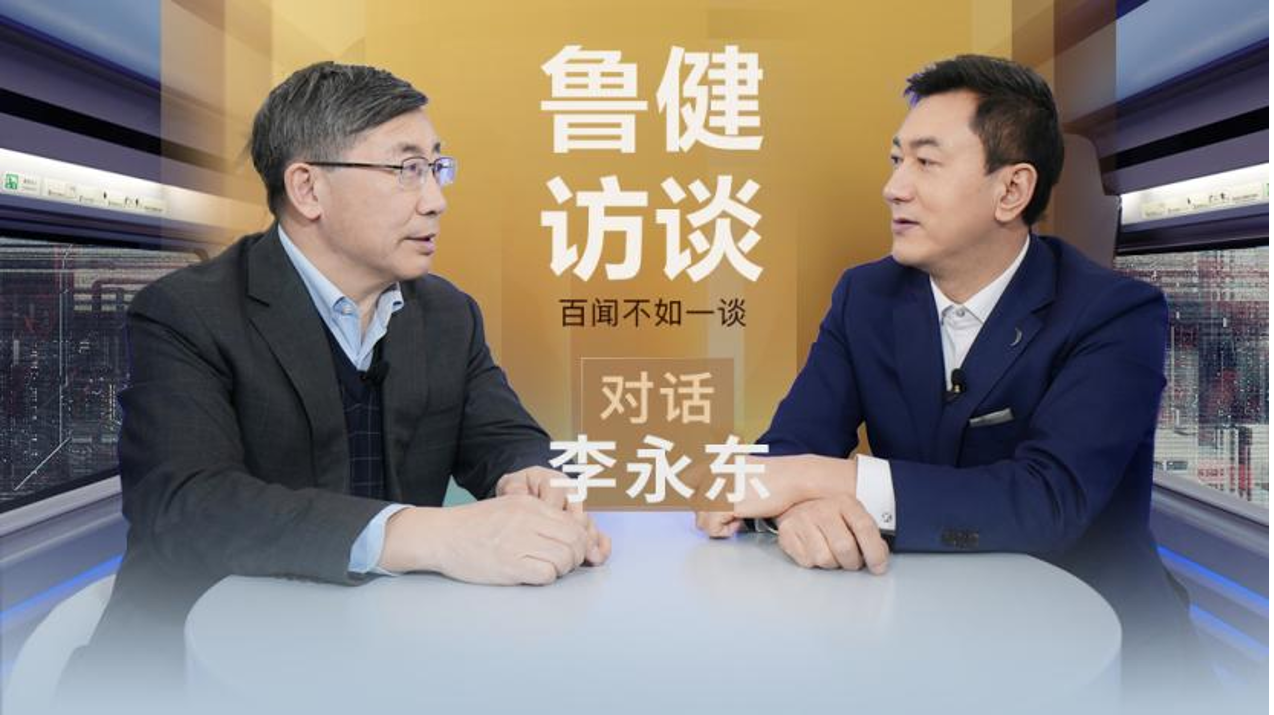Chapeau:
Li Yongdong, professor of the Department of Electrical Engineering of Tsinghua University and Head of the Green Transportation Drive and Efficient Energy Conversion Research Center of the Energy Internet Research Institute, was interviewed by the famous CCTV host Lu Jian, and they discussed the "heart" and "brain" of the high-speed trains of Beijing-Zhangjiakou line.
The following article is excerpted from the program “Lu Jian Interviews” of CCTV4.

Chinese international channel CCTV4 aims to "promote Chinese culture and serve global Chinese", providing news and cultural information, interaction and services for users around the world.
Among all 4,153 electric multiple units (EMUs) of China Railway, the "Ruixue Yingchun" Fuxing train of the Beijing-Zhangjiakou high-speed line has some uniqueness about it. It is tailored for the needs of the Beijing Winter Olympics, and for the first time in the world to achieve fully automatic driving at a speed of 350 kilometers per hour. It uses the Beidou navigation system to control its start, stop, and door opening, without any human intervention. Lu Jian, the host of the program “Lu Jian Interviews”, boarded this train and had a conversation with Li Yongdong, an expert in motor control. They discussed the "heart" and "brain" of the high-speed train of the Beijing-Zhangjiakou line.

Forty years ago, Li Yongdong came up with the aspiration of developing high-speed trains for his motherland while studying in France. After returning to China, he devoted himself to experiments on miniaturization of motor control equipment for 10 years, which came to great success. He has personally experienced the dispute over whether to apply the maglev technology or the wheel-rail technology for China's high-speed railway and witnessed the whole development process of China's high-speed railway from the initial introduction and adaptation to the current independent research and development.
"In the future, motor control will be more automated and intelligent, and artificial intelligence will be applied in motor control." Li Yongdong and his colleagues have never stopped their endeavor in the field of motor control research. It is exciting to think about what surprises they will bring in the future.
A Bond with the Railway for Four Decades
Li Yongdong was born in Zhangjiakou, next to the railway station. The scene of steam locomotives loaded with goods is an engraved memory. At the age of 4, Li Yongdong stayed up all night with his parents on a hard seat and came from Zhangjiakou to his grandfather's house on the outskirts of Beijing. These train-related experiences became an important part of his childhood memories. Today, by Beijing-Zhangjiakou high-speed railway, it takes only 50 minutes to travel from Beijing Qinghe Station to Zhangjiakou Taizicheng Station. "It's a huge progress. The speed in the old days was 35 kilometers per hour, now it is 350 kilometers per hour, which is ten times faster. ”
Li Yongdong was involved in the research and development of electric traction for high-speed trains - the AC motor vector control technology. This technology allows each car to have its own drive and control unit, making the train run more smoothly and faster. He compared the motor to the heart of the high-speed train, and said, “We study how to control the motor of the high-speed train, which is like adding a ‘brain’ to the ‘heart’. The ‘brain’ can monitor, think, and react to the way the ‘heart’ operates.”
Li Yongdong’s connection with railways began four decades ago, when most trains in China were green and slow. In the early 1980s, France built a high-speed railway from Paris to Lyon, operating at a speed of 270 kilometers per hour, which amazed the world. In 1983, Li Yongdong graduated from Harbin Institute of Technology and went to France to study at the Institut National Polytechnique de Toulouse. “My major was motor control. I casually asked my French classmates what kind of motor their high-speed railway used, and they said it was the top trade secret. That struck me hard.” Since then, Li Yongdong has nurtured a dream to develop high-speed trains for his motherland.
Trials and Failures
After returning to China, Li Yongdong joined the Department of Electrical Engineering at Tsinghua University. He led a laboratory specializing in the research on subway and electric locomotive traction systems at an early stage. "In 1988, China had already established a project (for the traction systems), and we went to the Ministry of Railways to discuss cooperation. At that time, the conditions were indeed very poor – the laboratory, the equipment and the devices were outdated. The devices we developed were very large, and there was no space for them on the train. So we had to start with miniaturizing the motor control equipment, and make a plan to develop new devices. ”
In the laboratory workshop near Dashanzi, Beijing, Li Yongdong and his colleagues kept experimenting, "The drive and protection circuits are very complex, if they are not designed well, they will burn out, and we would lose hundreds or thousands of yuan worth of devices. Everyone had to be very vigilant. The workshop was freezing in winter, so we put an electric heater under the feet of those seated students who worked on debugging the program, and the others just ran around to warm themselves up. ”
After 4 to 5 years of repeated experiments, the laboratory successfully launched the miniaturization of motor control equipment, which was then put into production, and first applied in the workshops of factories, power plants, and water supply plants." As the power of the equipment gradually increased, around 2001, we began trials of using this device on trains. From 1989 to 2001, we spent over a decade conducting experiments. ”
Committed to Developing Core Technologies Independently
From the initial introduction and adaptation to the current independent research and development, Li Yongdong has witnessed the whole development process of China's high-speed railway, and he has always held a belief that the core technology must come from independent research and development. "The initial stage is introducing and adapting foreign advanced technology, but the price of such introduction was very high, and the core technologies such as control software and signal software would not be shared with us. Eventually, we had to develop software independently."
Li Yongdong also experienced a dispute over whether to apply the maglev technology or the wheel-rail technology. He supported the more established wheel rail at that time, "Maglev technology was very advanced but expensive, at that time it was too much for China to afford. Wheel-rail motors were more practical." With the continuous development of science and technology and a strengthened economy, China has fully mastered maglev technology. “In July 2021, the 600-kilometer-per-hour maglev train officially rolled off the assembly line.”
Today, China's high-speed railway continues to "shorten" the distance between cities. According to the national plan, the Beijing-Taipei high-speed railway is expected to be completed and opened to traffic before 2035, which will bring great convenience to people along the line. "At present, the Beijing-Taipei high-speed railway adopts wheel-rail high-speed train, with an operating speed of 400 kilometers per hour and a test speed of 600 kilometers per hour."
In fact, 600 kilometers per hour is no longer the cap of a high-speed railway. With the advancement of science and technology, the idea of vacuum pipeline transportation is gradually becoming a reality. Li Yongdong said that China was also promoting the test of the vacuum pipeline maglev transportation system. "Adopting the vacuum pipeline means that the train travels in a completely sealed space with nearly no friction. Once the train starts, the power consumption is not high, and in theory, the speed of the train could reach thousands of kilometers per hour."
Motor Control Applications are Everywhere
In the motor laboratory, Li Yongdong showed Lu Jian the motor test of new energy vehicles. Working with motors every day and doing experiments for a long time can be boring. But Li Yongdong finds enjoyment. "For the motor, the wrong input will result in the wrong output. If the input is good enough, the output can be very stable, and the noise is very low." He said he found great joy in receiving satisfactory commissioning results. "There is a sense of accomplishment."
"China generates trillions of kilowatt-hours of electricity every year. Lighting accounts for just over ten per cent of total consumption, and computers account for about the same percentage. And more than 60 per cent are consumed by motors." Motor control applications are ubiquitous nowadays. Li Yongdong said that the future motor control will be more automated and intelligent. Artificial intelligence will be used in motor control. The combination of information society and traditional society will require motor control, "This borders on the fourth industrial revolution." Intelligence will promote the development of a zero-carbon or low-carbon society. "In the future, a room may be zero-carbon, with energy directly from solar or wind power." The majority of the power supply for the Beijing Winter Olympics was from wind power – the wind in Zhangbei lit up Beijing's lights. ”
Li Yongdong believes that from the perspective of motor control, China has the capability to lead the fourth industrial revolution. "China is now the largest manufacturer and consumer of motor control equipment and has achieved domestic circulation. China has the capability to lead the fourth industrial revolution. But of course, we must also learn from advanced foreign technology."
